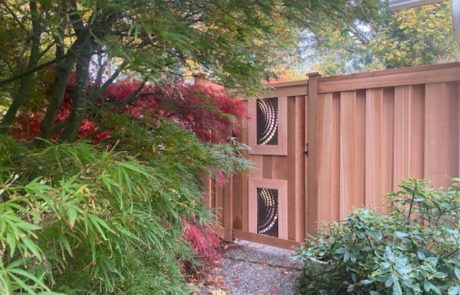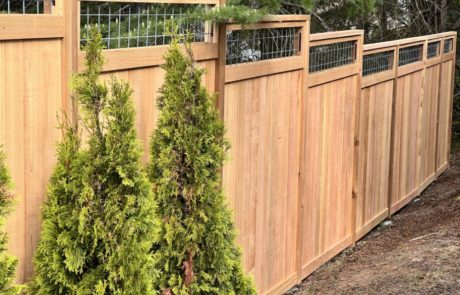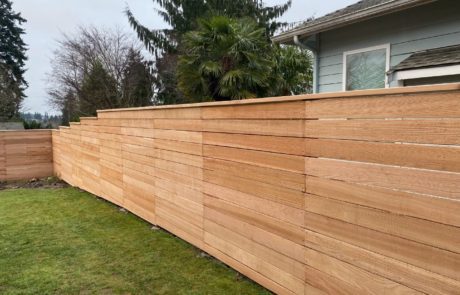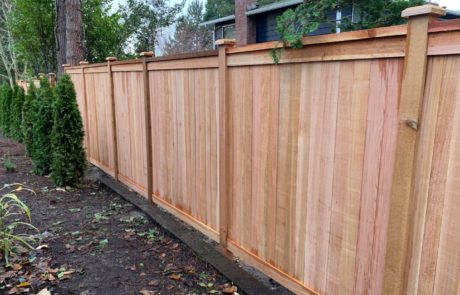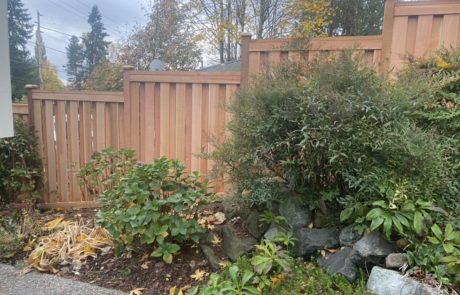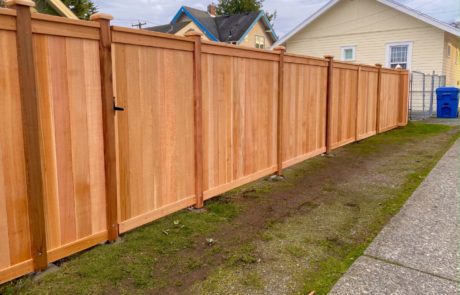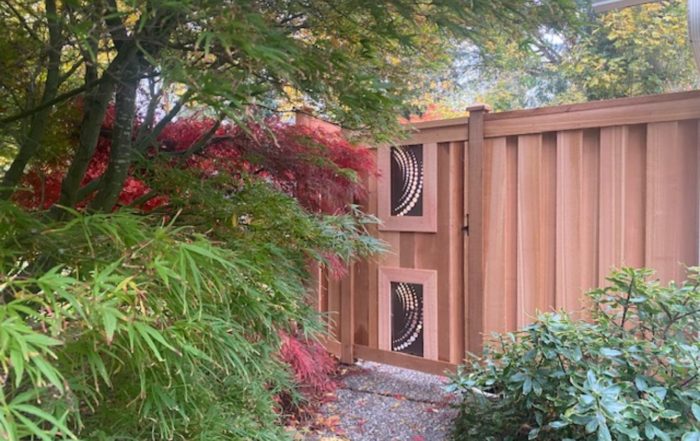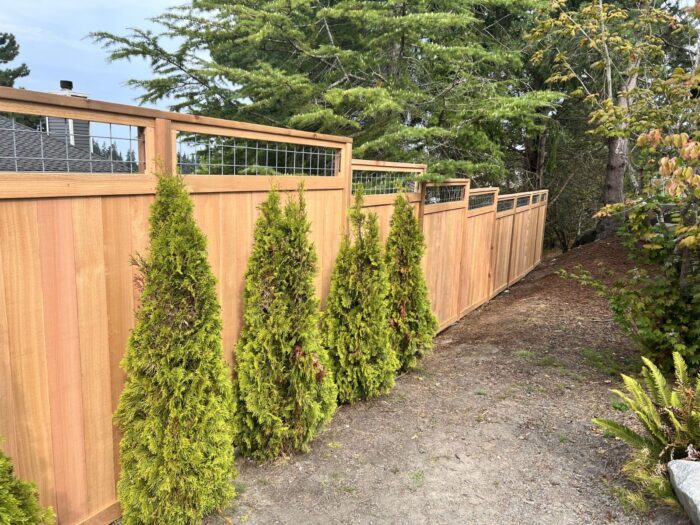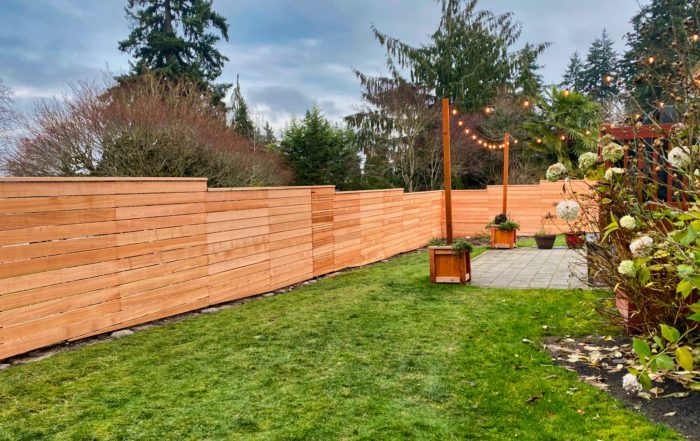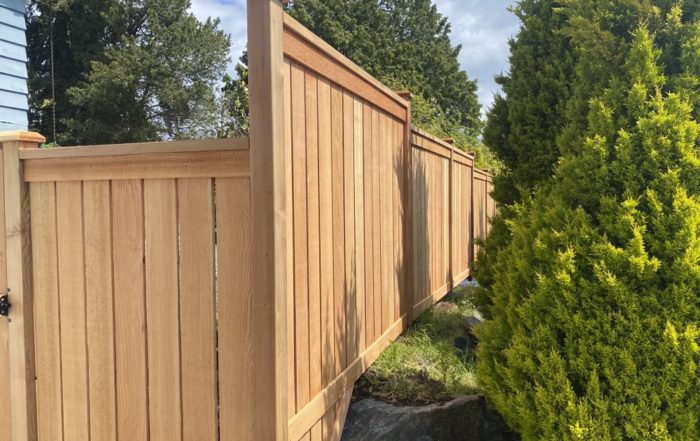Cedar Fence,Chain Link Fence,Fence Design,Installation,Maintenance,Materials,Metal Fence,Pets,Privacy Fence,Security,Vinyl Fence
Did you know that privacy fences offer an excellent way to create outdoor security, while still keeping your family safe and shielded from prying eyes?
When it comes to selecting the right type of fence for your home, there are a number of factors – including cost, design and materials as well as height – which must be taken into consideration. While solid or stockade-style fencing may provide greater protection than lattice styles in terms of blocking views from outside, they can also come at additional expense. So when deciding on the perfect solution for enhancing both safety and seclusion around your yard space; make sure you explore all options!
What is a privacy fence?
A privacy fence is an enclosed barrier made of wood, metal, vinyl, or other material that provides a physical separation between two areas while also blocking the view. A privacy fence typically stands 6 to 8 feet tall and consists of solid panels or lattice-style boards.
Among the many benefits of a privacy fence are increased privacy from nosy neighbors, added security, privacy for outdoor activities, and improved home value. A well built, attractive fence will also make for happy neighbors.
It’s important to note that some local laws may limit the height of your privacy fence—so it’s always best to check before you begin making any decisions about buying materials and constructing your fence.
Wood Privacy Fences
Wood privacy fences are a classic choice for many homes. They provide complete privacy and can be customized to fit any size or shape of yard. Plus, wood is relatively easy to work with, making it simple to install and maintain.
We recommend using Western Red Cedar for its durability, natural resistance to insects, natural beauty, and ease of maintenance. It’s the perfect choice for any Pacific Northwest home.
Benefits of Wood Privacy Fences
- Aesthetic Appeal: Wood privacy fences provide a classic look to any outdoor space that is timeless and attractive.
- Customizable: Wood can be easily shaped, cut, and trimmed to fit any size or shape of yard.
- Easy Installation: Installing a wood fence is relatively easy, making it an excellent choice for DIYers.
Drawbacks of Wood Privacy Fences
- Prone to Damage: Without proper maintenance, wood can be vulnerable to rot and insect damage.
- Maintenance: To keep your wood fence looking great, regular painting and staining may be required.
Choosing a high quality wood like Western Red Cedar will be more durable and require less maintenance. Its natural oils not only repel insects, it stands up in inclement weather conditions. Choosing a reputable fence contractor experienced with post on pipe construction to separate the posts from the ground will add years to your fence.
Vinyl Privacy Fences
Vinyl privacy fences provide the same level of security as a wood fence, with less maintenance. They are also easy to install and require little upkeep.
Benefits of Vinyl Privacy Fences
- Low Maintenance: With vinyl privacy fences, you don’t have to worry about rot or insect damage like with wood fencing.
- Durability: Vinyl is highly durable and can withstand extreme weather conditions.
Drawbacks of Vinyl Privacy Fences
- Limited Customization: Vinyl can be difficult to customize, so it may not fit your yard’s exact shape and size.
- Aesthetic Appeal: While it is attractive it doesn’t have the natural appeal of real wood.
Wrought Iron Privacy Fences
People don’t often think of wrought iron fences for privacy due to the open design. For wrought iron to be considered a privacy fence it will require the addition of privacy slats. Privacy slats made of wood, bamboo, vinyl, and metal mesh are simple add ons. Live and faux greenery are also poplar options to add privacy with a wrought iron fence.
Wrought iron privacy fences are durable and attractive providing a classic look that many homeowners love.
Benefits of Wrought Iron Privacy Fences
- Aesthetic Appeal: Wrought iron provides a classic look with an upscale feel.
- Durability: Wrought iron is very durable and can last for decades.
Drawbacks of Wrought Iron Privacy Fences
- Expensive: Wrought iron fences are more expensive than other types of fencing, making them a less popular option.
- High Maintenance: To keep wrought iron looking great, it requires regular maintenance to prevent rust and corrosion.
Chain Link Privacy Fences
Chain link is not technically considered a privacy fence because it doesn’t feature solid wall construction. However, it can easily provide plenty of privacy at a minimal cost with the addition of privacy slats.
Chain link privacy fences are a cost-effective alternative to wood and vinyl fences. They provide an effective barrier while still allowing some natural light in, making them a good choice for large yards or open spaces.
Benefits of Chain Link Privacy Fences
- Cost-Effective: Chain link privacy fences are a more affordable option than wood or vinyl fencing.
- Natural Light: Chain link allows some natural light into the yard, making it a great option for larger yards or open spaces.
Drawbacks of Chain Link Privacy Fences
- Low Privacy: Chain link does not provide as much privacy as other types of fences, making it more vulnerable to vandalism and theft.
- Unattractive: The chain links can look unattractive in some cases, so they are not always the best choice for a decorative fence.
How to choose the right privacy fence for your home
Choosing the right privacy fence can add value to your property and improve its aesthetic appeal. When choosing a privacy fence for your home, there are many factors to consider including cost, material type, durability, maintenance requirements, and design features.
- Cost: Evaluating the cost of different types of fence materials to find one that fits within your budget. Be careful when selecting a product that is too cheep, you’ll just end up having to replace it in a few years. A higher end wood like Cedar might be more expensive than Pine but it will last a lot longer.
- Material Type: Comparing the benefits and drawbacks of wood, vinyl, wrought iron, and chain link fences to determine which is best suited for your needs.
- Durability: Assessing the ability of the chosen material to withstand weather, pests, and other elements. This is particularly important in areas like the Pacific Northwest where inclement weather is a factor.
- Maintenance Requirements: Determining how much time you are willing to dedicate to maintenance such as painting or staining. Higher end materials like Western Red Cedar will keep the need for maintenance to a minimum.
- Design Features: Selecting features like gates, pickets, or lattice panels that will fit in with your home’s style. It’s also a good idea to consider any community requirements first.
Installation tips for privacy fences
Choosing the right fence for your property is important, it is equally essential to ensure its proper installation. Poorly installed or improperly maintained fences can be easily damaged due to weather, pests, and other types of wear and tear. Installing a privacy fence correctly helps to ensure it will last for many years to come.
Some things to consider:
- Follow Local Building Codes: Before beginning your fencing project, make sure you understand any local building regulations or codes that may apply. This information can usually be found on your city or county’s website.
- Clear the Area: Before starting to build, make sure to clear the area of any debris or plants that may interfere with construction.
- Measure Twice, Cut Once: When cutting fence panels and posts, be sure to measure twice and cut once to ensure a precise fit.
- Secure Posts in Concrete: To ensure a sturdy fence, posts should be securely anchored in concrete.
- Attach Panels to Posts: Use screws or nails to attach the panels to the posts for added stability.
Tips to keep your privacy fence looking great for years
- Select the Right Wood: Choosing the right type of wood for your privacy fence is essential in ensuring it will last a long time. Selecting a species that is strong, durable, and able to withstand weather and insect damage is key. Cedar and redwood are both good choices as they have natural oils that resist rot and decay. Pressure-treated pine is also popular but will require a bit more maintenance over time.
- Use High Quality Fasteners: High-quality fasteners (screws, nails, etc.) should be used when installing your privacy fence to ensure stability over time. It’s also important to check all fasteners periodically for any signs of rust or wear-and-tear caused by weather or other elements.
- Seal the Wood: Applying a sealant to your wood fence can help protect it from water damage, fading from UV rays, and normal wear-and-tear caused by everyday use. Sealing the wood will also make it easier to clean in the future—simply reapply every few years to keep it looking its best!
- Use Non-toxic Paint/Stain: When selecting paint or stain for your privacy fence, choose ones that are non-toxic and free of volatile organic compounds (VOCs). These kinds of paints/stains are safer for people, pets, and the environment—plus they look great too! Be sure to read product labels carefully before applying anything to your fence.
- Prune Regularly: Make sure you trim branches along the top of your fence regularly so no trees can grow on or near it — this will help reduce wear-and tear over time! If you’ve got any shrubbery near the bottom of your fence line be sure to keep it well pruned too as this can also cause added strain on the structure over time.
- Clean Gently: Cleaning your wood privacy fence doesn’t have to be an ordeal—in fact there are plenty of ways you can do it without damaging the material or having to use harsh chemicals! You can try using an oxygen bleach solution (or white vinegar) mixed with warm water as a gentle cleaner—just make sure you avoid pressure washers which could cause excess damage if not used correctly!
- Inspect Regularly: Taking a few minutes each year (or even more often depending on location) to inspect your privacy fence for any signs of damage is always a good idea! Look out for things like loose boards, splintering wood, cracks in posts/rails – all these may indicate areas where repairs may be needed in order to keep your fencing secure and sturdy over time!
How to decorate a privacy fence to make it more attractive
Adding some decorative touches to your privacy fence can make it look more attractive and increase its curb appeal. Here are a few ideas for decorating a privacy fence:
- Hanging Lights: String lights along the top of the fence to add some illumination and ambiance.
- Painting or Staining: Add color to
- Painting your privacy fence: Use paint to add a unique design or pattern that reflects your personal style.
- Adding lights: Hang string lights along the fence for a romantic, cozy atmosphere.
- Hanging planters: Attach hanging planters to the fence and fill them with colorful flowers or plants. This will brighten up the space and create an inviting atmosphere.
- Adding trellis: Installing a trellis on top of the fence can give it an elegant, refined look.
- Attaching lattice panels: Use lattice panels to create a more decorative look with plenty of character.
- Landscaping Consider incorporating landscaping elements into your design.
Examples of different types of privacy fences installed in homes
Conclusion
There are many different types of privacy fences available on the market today, each with its own set of benefits and drawbacks. It is important to choose the right fence for your home and property, and to follow the proper installation and maintenance tips to ensure its longevity. By decorating your privacy fence in a unique way, you can add some personality and style to an otherwise bland space.
FAQ
Q: What is a privacy fence?
A: A privacy fence is an enclosed barrier made of wood, metal, vinyl or other material that provides a physical separation between two areas while also blocking the view
Q: Are neighbors required to share the cost of a new fence if built on a property line?
A: Per RCW 16.60.030: When multiple landowners have adjoining properties that are enclosed by a single fence, and one party requires the construction of a partition fence for the protection of their interests, the other parties must be notified and contribute equally to the cost of erecting one-half of the fence along their property line.
Washington State: Commonly Asked Questions About Sharing a Fence With Your Neighbors
Q: How tall is a privacy fence?
A: Typically between 6 and 8 feet tall. Be sure to check local height restrictions before construction.
Q: What is the best type of wood for privacy fence?
A: Western Red Cedar. In addition to its endless customizability and stunning natural beauty its exceptionally durable and resistant to insects and rot.
Q: What materials are used to make privacy fences?
A: Privacy fences can be made of a variety of materials, including wood, vinyl, chain link, metal, and more.
Q: How often should I inspect my fence for damage?
A: It’s important to inspect your fence regularly for signs of wear or damage. Doing so will help maintain its quality and appearance.
Q: Can I paint my privacy fence?
A: Yes! Painting your fence is a great way to add color and interest to the space. Just make sure you use a weather-resistant paint if your fence is exposed to the elements.
Q: How long does a privacy fence usually last?
A: The lifespan of a privacy fence depends on the materials used and how well it is maintained. A quality material like Western Red Cedar can last up to 30 years with proper care.
Q: What are some ways to decorate a privacy fence?
A: Decorating your privacy fence can add style and character to an otherwise plain space. You can hang string lights, attach planters, add lattice panels, or paint designs onto the fence to make it more attractive.
Q: Are there any regulations for installing a privacy fence?
A: Depending on where you live, there may be certain regulations surrounding the installation of a privacy fence. Be sure to check with your local government before proceeding with the installation process.
Q: What are some tips for maintaining a privacy fence?
A: Regular maintenance is important for preserving the quality and appearance of your privacy fence. Make sure to inspect it for damage or wear, repair any issues promptly, and consider staining or painting it periodically. Finally, don’t forget to secure posts and anchors in concrete if needed.

